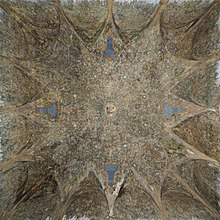
Leonardo di ser Piero da Vinci was an Italian polymath of the High Renaissance who was active as a painter, draughtsman, engineer, scientist, theorist, sculptor, and architect. While his fame initially rested on his achievements as a painter, he has also become known for his notebooks, in which he made drawings and notes on a variety of subjects, including anatomy, astronomy, botany, cartography, painting, and paleontology. Leonardo is widely regarded to have been a genius who epitomized the Renaissance humanist ideal, and his collective works comprise a contribution to later generations of artists matched only by that of his younger contemporary Michelangelo.

Vigevano is a comune (municipality) in the province of Pavia, in the Italian region of Lombardy. A historic art town, it is also renowned for shoemaking and is one of the main centres of Lomellina, a rice-growing agricultural district. Vigevano received the honorary title of city with a decree of Duke Francis II Sforza on 2 February 1532. It is famed for its Renaissance Piazza Ducale in the centre of the town.

Ludovico Maria Sforza, also known as Ludovico il Moro, and called the "arbiter of Italy" by historian Francesco Guicciardini, was an Italian nobleman who ruled as the Duke of Milan from 1494 to 1499.

Cecilia Gallerani was the favourite and most celebrated of the many mistresses of Ludovico Sforza, known as Lodovico il Moro, Duke of Milan. She is best known as the subject of Leonardo da Vinci's painting The Lady with an Ermine. While posing for the painting, she invited Leonardo, who at the time was working as court artist for Sforza, to meetings at which Milanese intellectuals discussed philosophy and other subjects. Cecilia herself presided over these discussions.

Santa Maria delle Grazie is a church and Dominican convent in Milan, northern Italy, and a UNESCO World Heritage Site. The convent contains the mural of The Last Supper by Leonardo da Vinci, which is in the refectory.

Bartolomeo Suardi was an Italian painter and architect, mainly active in his native Milan.

The Castello Sforzesco is a medieval fortification located in Milan, Northern Italy. It was built in the 15th century by Francesco Sforza, Duke of Milan, on the remnants of a 14th-century fortification. Later renovated and enlarged, in the 16th and 17th centuries it was one of the largest citadels in Europe. Extensively rebuilt by Luca Beltrami in 1891–1905, it now houses several of the city's museums and art collections.

The Portrait of a Musician is an unfinished painting widely attributed to the Italian Renaissance artist Leonardo da Vinci, dated to c. 1483–1487. Produced while Leonardo was in Milan, the work is painted in oils, and perhaps tempera, on a small panel of walnut wood. It is his only known male portrait painting, and the identity of its sitter has been closely debated among scholars.

Beatrice d'Este was Duchess of Bari and Milan by marriage to Ludovico Sforza. She was one of the most important personalities of the time and, despite her short life, she was a major player in Italian politics. A woman of culture, an important patron, a leader in fashion: alongside her illustrious husband she made Milan one of the greatest capitals of the European Renaissance. With her own determination and bellicose nature, she was the soul of the Milanese resistance against the enemy French during the first of the Italian Wars, when her intervention was able to repel the threats of the Duke of Orléans, who was on the verge of conquering Milan.

The Codex Trivulzianus is a manuscript by Leonardo da Vinci that originally contained 62 sheets, but today only 55 remain. It documents Leonardo's attempts to improve his modest literary education, through long lists of learned words copied from authoritative lexical and grammatical sources. The manuscript also contains studies of military and religious architecture.
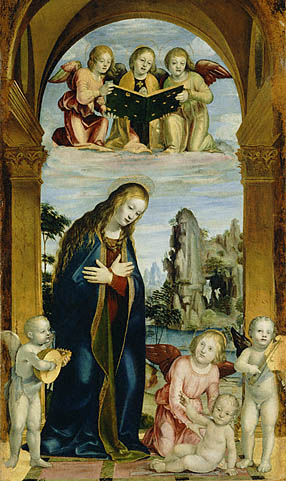
BernardoZenale was an Italian painter and architect.

Leonardo's crossbow designs are a series of shooting weapon schematics designed by Leonardo da Vinci that are in the Codex Atlanticus. One version, a self-spanning infantry weapon called the Rapid Fire Crossbow, is found on sheets 143r, 153r, and 155r. The other is the Giant Crossbow design intended to be a mounted siege weapon found on sheet 149a in the Codex.
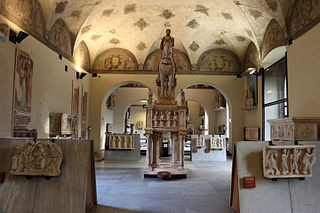
The Museo d'Arte Antica is an art museum in the Castello Sforzesco in Milan, in Lombardy in northern Italy. It has a large collection of sculpture from late antiquity and the medieval and Renaissance periods. The various frescoed rooms of the museum house an armoury, a tapestry room, some funerary monuments, Michelangelo's Rondanini Pietà and two medieval portals.

The Leonardeschi were the large group of artists who worked in the studio of, or under the influence of, Leonardo da Vinci. They were artists of Italian Renaissance painting, although his influence extended to many countries within Europe.
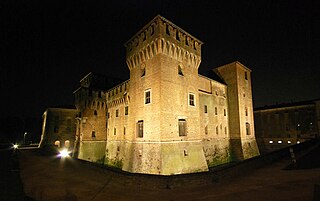
The Castello di San Giorgio is part of the Ducal palace of Mantua. It is a moated rectangular castle, each of which's four corners has a large tower and the moat is crossed by three drawbridges.

The Visconti Castle, or Castello Visconteo, is a castle in the town of Cusago near Milan, Lombardy, Northern Italy. It was built in the 14th century by Bernabò Visconti and used as a hunting lodge by him and other Visconti family members. The castle underwent significant changes in the Renaissance period; today, it is in neglected conditions.
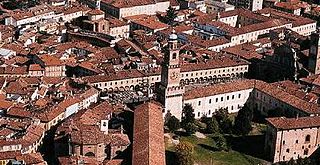
The Visconti-Sforza Castle is a mediaeval castle located in the centre of the city of Vigevano, Lombardy, Northern Italy. In the 14th and 15th centuries, members of the Visconti and Sforza houses, lords and dukes of Milan, transformed a previous fortification into a vast family resort. The castle was part of a wider plan of urban development for Vigevano, which included the erection of other buildings and the construction of the central Piazza Ducale.

Leonardo is a historical drama television series created by Frank Spotnitz and Steve Thompson. The series was produced by Italian Lux Vide in collaboration with Rai Fiction, Sony Pictures Entertainment, with Frank Spotnitz's Big Light Productions and Freddie Highmore's Alfresco Pictures in association with France Télévisions and RTVE.

Leonardo da Vinci's Vineyard is a vineyard the Duke of Milan, Ludovico Maria Sforza best known as Ludovico il Moro, gave as a gift to Leonardo da Vinci in 1498 while he was working on the painting of Last Supper in the nearby refectory of the cathedral and Dominican convent of Santa Maria delle Grazie. It was a gesture to give credit for the many admirable works Leonardo had been creating for the Duke.

Casa Atellani, or also Casa degli Atellani, is a demorial that belonged to Ludovico Sforza, Duke of Milan, the last surviving trace of the ancient Borgo delle Grazie. Historically part of the Sestiere di Porta Vercellina, today it is located at numbers 66 and 67 of Corso Magenta. It was owned by the Castellini Baldissera family.
